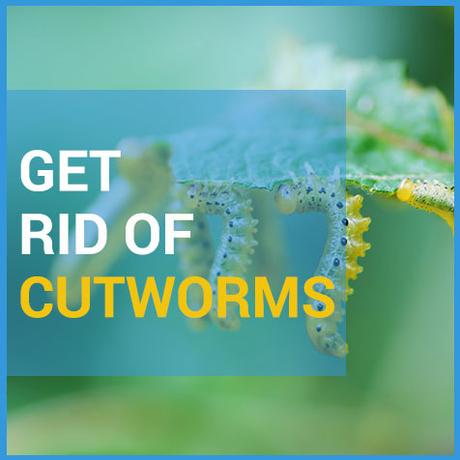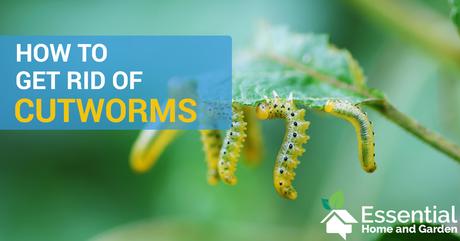
One of my worst gardening experiences entailed going out to what had been a healthy, vibrant garden, only to find those healthy plants literally cut through and lying on the ground. For the home gardener and the farmer alike, pests are one of the biggest impediments to healthy plants and high yields. There are countless pests and threats to your garden, but one of the most pernicious is the cutworm. They can be found on any number of common garden plants, and if not addressed, can wreak real havoc on a garden.

How To Identify Cutworms
So how do you know if what you have eating your plants are actually cutworms and not some other pest? Let's take a look at how to identify these hungry caterpillars.
What Are Cutworms?
Cutworms are a type of caterpillar that will eventually turn into a moth - this is the larvae stage of many types of moths. There are a number of varieties of cutworm, but black cutworms are the most common.
They are a difficult pest in that when eggs are laid in the fall, the cutworms can actually survive the winter, hatching in the early spring to take advantage of seedlings and other young plants. They will literally cut through a stem of a seedling, killing the plant and causing a huge amount of damage to an otherwise healthy garden.
It's incredibly the amount of havoc these little critters can have on your gorgeous garden.
Finding Cutworms
It is easiest to look for cutworms around dusk. They tend to chew through plants near ground level, so this is where to look for them. Cutworms are often mistaken for grubs, and how you treat them is a little different, so make sure that when you are diagnosing your pest problem, you are sure that what you are dealing with is a cutworm.
Unfortunately, cutworms come in a range of appearances. They can be just a few centimeters long to a few inches long. They can be spotted, plain colored, or striped. Cutworms range in color from gray to pink to black. As noted above, black cutworms are among the most common variety and they can be identified by the small dark spots that appear across their bodies. When fully fledged, these cutworms turn into one of the more common types of moths we are all familiar with.
How To Get Rid Of Cutworms
There are a number of methods for getting rid of cutworms that have varying degrees of effectiveness. Which method will work best for the problem at hand will have to do with the severity of the problem. When I find them, my thoughts immediately go to how to kill cutworms, as one generally indicates more and they can quickly take their toll on even the healthiest garden.
What follows are a number of effective means of getting rid of cutworms - I have used all of them at one time or another and they are all effective ways at treating the problem, whether it is a large or small one.
Make cutworm collars for your plants
If the problem isn't too out of hand and the garden space is of a manageable size, homemade collars are often a really great solution to cutworms. These can be made from a range of household materials including foil, paper, and cardboard.
Basically what you need to do is to create a tube that can be slid over the stem of the plant that touches the ground and goes a few inches up the stem. It is even more effective if you push the collar a bit underground as well.
Pesticide
If the problem is really bad and you have an infestation of cutworms, chemical solutions may be the best way to deal with the problem. The best pesticide for cutworms will depend on a few different factors.
There are a number of natural solutions that, while they do have their own set of concerns, are not environmental contaminants like traditional pesticides.
It should be noted that BT (Bacillus thuringiensis), one of the more common natural remedies for cutworms and other pests has been shown to cause damage to butterfly populations.
Hand pick
This is another good solution for minor problems with cutworms. To do this, all one needs is a flashlight and some soapy water.
After dark, using the flashlight, manually remove the cutworms and place them in soapy water. You may need to repeat this every few days until the problem is curtailed.
Old fashioned remedies
There are a number of tried and true methods that can be fairly effective against small numbers of cutworms.
- Sprinkling eggshells or coffee grounds can be an effective deterrent
- Oak leaf mulch is another deterrent.
- You can also try what is often called "companion cropping" by planting certain crops (in this case cabbage), which can also help reduce issues with cutworms. Not to mention, you get bonus cabbage!
How To Keep Cutworms Away
One way to help avoid cutworms, to begin with, is to make sure that you clear all leaf litter and other organic debris away from your garden beds. This is a prime spot where eggs are laid and removing this material is a good way to help prevent problems before they begin. But even taking these steps to avoid the problem is often not enough, they will still show up in your garden, but it does make sense to do what you can to try to avoid the problem as much as possible.
Be Prepared
No matter how large or small the area one is cultivating, pests are always going to be part of the proverbial equation. With foresight and planning, it is pretty easy to keep these problems under control so they do not cause untold amounts of damage to your garden.
Cutworms are a common problem for gardeners, particularly early in the growing season, and if left untreated, they can devastate a garden very quickly. Knowing how to identify, prevent, and manage these pests is part and parcel to a successful garden.
With a bit of knowhow, you can beat the bugs!
Image credits:
By Rasbak [ GFDL or CC-BY-SA-3.0], from Wikimedia Commons
